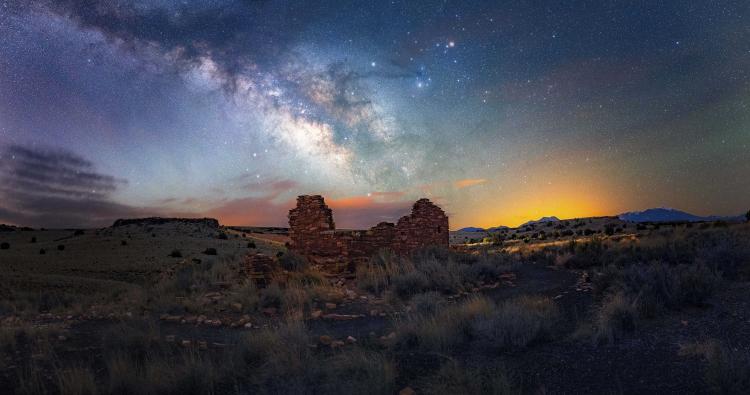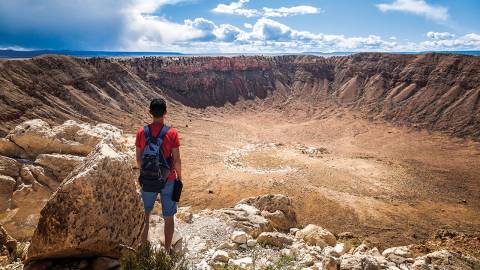5 Reasons Why Flagstaff is an Astrotourism Destination
Flagstaff attracts people from all walks of life, whether they are searching for outdoor thrills, historic hotspots, or an escape from the desert heat. It's a stop on historic Route 66, one of the first highways to be built in the United States.

It's a vital point to refuel and recharge on the way to the world-famous Grand Canyon, one of the world's 7 natural wonders. However, one of Flagstaff's lesser-known claims to fame is its status as a hub for astronomy enthusiasts from around the world. So, what exactly makes this eclectic mountain town an astrotourism destination? Read on to find out!
1. It's the world's first International Dark Sky City
Flagstaff offers a starry safe haven in a world where pristine dark skies are becoming increasingly difficult to come by. The Dark Sky City designation is given to communities that commit to preserving dark skies both in policy and in practice. Flagstaff was named the world’s first International Dark Sky City by the International Dark-Sky Association (IDA) on October 24, 2001. Since then, over 180 places including towns, cities, and national parks and more have been designated by the IDA worldwide.
When walking in the streets of Flagstaff, you may notice that the street lamps and other outdoor lights have an orange-yellow glow to them, rather than a white one. This is because they're Narrow Band Amber LEDs! This type of lighting creates far less glare than white light, which is the main contributor to light pollution in urban areas. Flagstaff street lights are also sufficiently shielded so that the light is directed downwards rather than up at the sky. These lighting protocols, among others, help preserve and protect Flagstaff's gorgeous dark skies, making it a starry safe haven for astronomers, backyard stargazers, and curious minds in a world where pristine dark skies are becoming increasingly difficult to come by. This work is done in large part by the Flagstaff Dark Skies Coalition, the result of an innovative effort to ensure that Flagstaff residents and visitors have the opportunity to be awestruck by the cosmos.

2. You can stargaze through telescopes at Lowell Observatory
For more than 125 years, Lowell Observatory has connected people to the universe, through education, exploration and discovery. Visit their Mars Hill campus in the evening to stargaze through the cutting edge telescopes of the Giovale Open Deck Observatory, or through the world-famous Clark Telescope, which is also more than 125 years old. Walk in the footsteps of prolific figures such as their founder Percival Lowell, Pluto discoverer Clyde Tombaugh, the astronauts of the Apollo Program, and numerous others. History is made every day by their brilliant team of researchers, and discovery awaits you, too. Look through their historic and cutting-edge telescopes yourself to see our universe like you’ve never seen it before.

3. It's the discovery place of Pluto
It was right here in Flagstaff, at Lowell Observatory, that a young farm boy named Clyde Tombaugh made his groundbreaking discovery of the distant planet Pluto on February 18, 1930, completing Percival Lowell's lifelong search for what he called 'Planet X.' Each year, Lowell Observatory celebrates the groundbreaking discovery that put Flagstaff, the Home of Pluto, on the map with the I Heart Pluto Festival. This city-wide event includes food, beverages, tours, and more. Learn more and purchase tickets on the I Heart Pluto website!

4. Every astronaut who walked on the Moon trained here
You read that correctly: the city of Flagstaff played a key role in preparing for the Apollo Moon missions a half century ago. All astronauts who walked on the Moon, including Neil Armstrong, Alan Shepard, Buzz Aldrin, and Flagstaff scientist Jack Schmitt, trained in Flagstaff and northern Arizona at multiple locations. Artists teamed with scientists to create detailed lunar maps at Lowell Observatory, and several of the Moon-bound astronauts visited Lowell to study these maps in 1963. Using explosives, geologists created a simulated lunar surface in the cinder fields near Sunset Crater, complete with a network of craters modeled after craters on the surface of the Moon. These fields were ideal for training astronauts and testing equipment, including lunar rover vehicle simulators. Today, you can visit the sites that were integral in training the Apollo 11 astronauts and ensuring the mission's success.

5. Meteor Crater & Barringer Space Museum are just a short trip away
Located in Winslow, Arizona, 50,000 year-old Meteor Crater and the accompanying Barringer Space Museum are can't-miss destinations for adventurers and space enthusiasts visiting northern Arizona. The crater was left as the result of a meteorite (estimated to be about 150 feet across and weighing several hundred thousand tons) striking the Earth with a force 150 times greater than an atomic bomb explosion. Get an up-close look at the crater from the indoor viewing area of the visitor center, outside on one of the observation decks and self-guided trails, or on a guided tour along the rim. Explore the Barringer Museum, which includes immersive multimedia presentations and fascinating exhibits like the Moon module replica that was used to train the Apollo 11 astronauts.
About the Author

Madison Mooney
Madison Mooney graduated from Northern Arizona University in 2019, earning a Bachelor of the Arts degree in English. She is a Content Marketing Specialist at Lowell Observatory, writing about history, the cosmos, and local events. She loves living in Flagstaff, drinking iced chai lattes, and hanging out with her cats, Nyx and Purrsephone.


